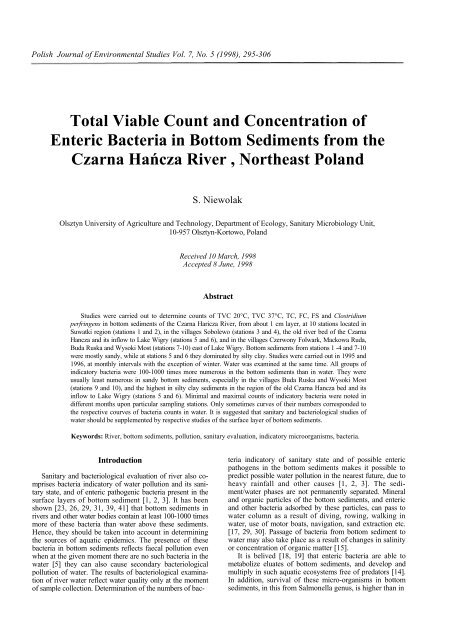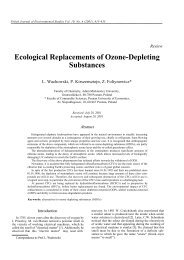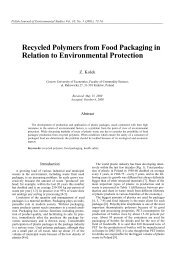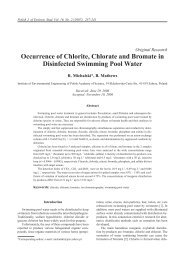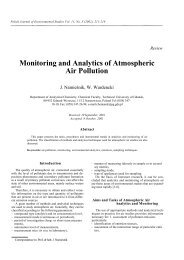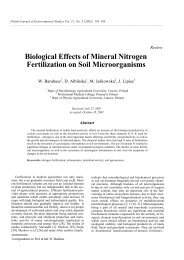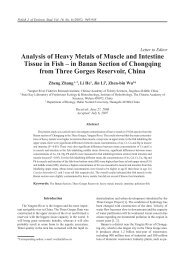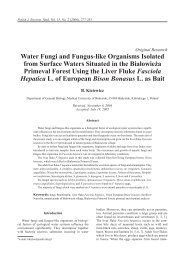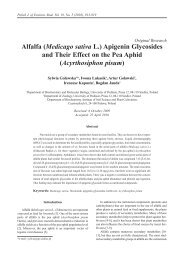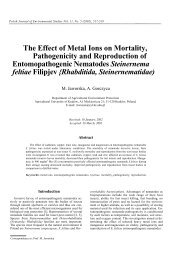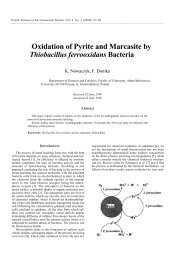Total Viable Count and Concentration of Enteric Bacteria in Bottom ...
Total Viable Count and Concentration of Enteric Bacteria in Bottom ...
Total Viable Count and Concentration of Enteric Bacteria in Bottom ...
Create successful ePaper yourself
Turn your PDF publications into a flip-book with our unique Google optimized e-Paper software.
Polish Journal <strong>of</strong> Environmental Studies Vol. 7, No. 5 (1998), 295-306<br />
<strong>Total</strong> <strong>Viable</strong> <strong>Count</strong> <strong>and</strong> <strong>Concentration</strong> <strong>of</strong><br />
<strong>Enteric</strong> <strong>Bacteria</strong> <strong>in</strong> <strong>Bottom</strong> Sediments from the<br />
Czarna Hańcza River , Northeast Pol<strong>and</strong><br />
S. Niewolak<br />
Olsztyn University <strong>of</strong> Agriculture <strong>and</strong> Technology, Department <strong>of</strong> Ecology, Sanitary Microbiology Unit,<br />
10-957 Olsztyn-Kortowo, Pol<strong>and</strong><br />
Received 10 March, 1998<br />
Accepted 8 June, 1998<br />
Abstract<br />
Studies were carried out to determ<strong>in</strong>e counts <strong>of</strong> TVC 20°C, TVC 37°C, TC, FC, FS <strong>and</strong> Clostridium<br />
perfr<strong>in</strong>gens <strong>in</strong> bottom sediments <strong>of</strong> the Czarna Haricza River, from about 1 cm layer, at 10 stations located <strong>in</strong><br />
Suwatki region (stations 1 <strong>and</strong> 2), <strong>in</strong> the villages Sobolewo (stations 3 <strong>and</strong> 4), the old river bed <strong>of</strong> the Czarna<br />
Hancza <strong>and</strong> its <strong>in</strong>flow to Lake Wigry (stations 5 <strong>and</strong> 6), <strong>and</strong> <strong>in</strong> the villages Czerwony Folwark, Mackowa Ruda,<br />
Buda Ruska <strong>and</strong> Wysoki Most (stations 7-10) east <strong>of</strong> Lake Wigry. <strong>Bottom</strong> sediments from stations 1 -4 <strong>and</strong> 7-10<br />
were mostly s<strong>and</strong>y, while at stations 5 <strong>and</strong> 6 they dom<strong>in</strong>ated by silty clay. Studies were carried out <strong>in</strong> 1995 <strong>and</strong><br />
1996, at monthly <strong>in</strong>tervals with the exception <strong>of</strong> w<strong>in</strong>ter. Water was exam<strong>in</strong>ed at the same time. All groups <strong>of</strong><br />
<strong>in</strong>dicatory bacteria were 100-1000 times more numerous <strong>in</strong> the bottom sediments than <strong>in</strong> water. They were<br />
usually least numerous <strong>in</strong> s<strong>and</strong>y bottom sediments, especially <strong>in</strong> the villages Buda Ruska <strong>and</strong> Wysoki Most<br />
(stations 9 <strong>and</strong> 10), <strong>and</strong> the highest <strong>in</strong> silty clay sediments <strong>in</strong> the region <strong>of</strong> the old Czarna Hancza bed <strong>and</strong> its<br />
<strong>in</strong>flow to Lake Wigry (stations 5 <strong>and</strong> 6). M<strong>in</strong>imal <strong>and</strong> maximal counts <strong>of</strong> <strong>in</strong>dicatory bacteria were noted <strong>in</strong><br />
different months upon particular sampl<strong>in</strong>g stations. Only sometimes curves <strong>of</strong> their numbers corresponded to<br />
the respective courves <strong>of</strong> bacteria counts <strong>in</strong> water. It is suggested that sanitary <strong>and</strong> bacteriological studies <strong>of</strong><br />
water should be supplemented by respective studies <strong>of</strong> the surface layer <strong>of</strong> bottom sediments.<br />
Keywords: River, bottom sediments, pollution, sanitary evaluation, <strong>in</strong>dicatory microorganisms, bacteria.<br />
Introduction<br />
Sanitary <strong>and</strong> bacteriological evaluation <strong>of</strong> river also comprises<br />
bacteria <strong>in</strong>dicatory <strong>of</strong> water pollution <strong>and</strong> its sanitary<br />
state, <strong>and</strong> <strong>of</strong> enteric pathogenic bacteria present <strong>in</strong> the<br />
surface layers <strong>of</strong> bottom sediment [1, 2, 3]. It has been<br />
shown [23, 26, 29, 31, 39, 41] that bottom sediments <strong>in</strong><br />
rivers <strong>and</strong> other water bodies conta<strong>in</strong> at least 100-1000 times<br />
more <strong>of</strong> these bacteria than water above these sediments.<br />
Hence, they should be taken <strong>in</strong>to account <strong>in</strong> determ<strong>in</strong><strong>in</strong>g<br />
the sources <strong>of</strong> aquatic epidemics. The presence <strong>of</strong> these<br />
bacteria <strong>in</strong> bottom sediments reflects faecal pollution even<br />
when at the given moment there are no such bacteria <strong>in</strong> the<br />
water [5] they can also cause secondary bacteriological<br />
pollution <strong>of</strong> water. The results <strong>of</strong> bacteriological exam<strong>in</strong>ation<br />
<strong>of</strong> river water reflect water quality only at the moment<br />
<strong>of</strong> sample collection. Determ<strong>in</strong>ation <strong>of</strong> the numbers <strong>of</strong> bac-<br />
teria <strong>in</strong>dicatory <strong>of</strong> sanitary state <strong>and</strong> <strong>of</strong> possible enteric<br />
pathogens <strong>in</strong> the bottom sediments makes it possible to<br />
predict possible water pollution <strong>in</strong> the nearest future, due to<br />
heavy ra<strong>in</strong>fall <strong>and</strong> other causes [1, 2, 3]. The sediment/water<br />
phases are not permanently separated. M<strong>in</strong>eral<br />
<strong>and</strong> organic particles <strong>of</strong> the bottom sediments, <strong>and</strong> enteric<br />
<strong>and</strong> other bacteria adsorbed by these particles, can pass to<br />
water column as a result <strong>of</strong> div<strong>in</strong>g, row<strong>in</strong>g, walk<strong>in</strong>g <strong>in</strong><br />
water, use <strong>of</strong> motor boats, navigation, s<strong>and</strong> extraction etc.<br />
[17, 29, 30]. Passage <strong>of</strong> bacteria from bottom sediment to<br />
water may also take place as a result <strong>of</strong> changes <strong>in</strong> sal<strong>in</strong>ity<br />
or concentration <strong>of</strong> organic matter [15].<br />
It is belived [18, 19] that enteric bacteria are able to<br />
metabolize eluates <strong>of</strong> bottom sediments, <strong>and</strong> develop <strong>and</strong><br />
multiply <strong>in</strong> such aquatic ecosystems free <strong>of</strong> predators [14].<br />
In addition, survival <strong>of</strong> these micro-organisms <strong>in</strong> bottom<br />
sediments, <strong>in</strong> this from Salmonella genus, is higher than <strong>in</strong>
296 Niewolak S.<br />
water, <strong>and</strong> bottom sediments may be a reservoir <strong>of</strong> these<br />
bacteria [5, 27, 40].<br />
In view <strong>of</strong> this, exam<strong>in</strong>ation <strong>of</strong> bottom sediments for the<br />
presence <strong>of</strong> bacteria <strong>in</strong>dicatory <strong>of</strong> sanitary state <strong>and</strong> <strong>of</strong> pathogenic<br />
enteric bateria may supply <strong>in</strong>formation on water<br />
quality <strong>in</strong> the nearest future [1, 2, 3]. So far there is no<br />
legislation requir<strong>in</strong>g that sanitary-bacteriological exam<strong>in</strong>ations<br />
comprised also bottom sediments <strong>of</strong> rivers <strong>and</strong> other<br />
waters important for recreation <strong>and</strong> aquaculture. There are<br />
also no st<strong>and</strong>ard methods <strong>of</strong> collect<strong>in</strong>g bottom sediments<br />
for such studies, although the first steps have already been<br />
made <strong>in</strong> this direction [1, 2, 3].<br />
This paper presents the results <strong>of</strong> sanitary <strong>and</strong> bacteriological<br />
studies determ<strong>in</strong><strong>in</strong>g the counts <strong>of</strong> bacteria <strong>in</strong>dicatory<br />
<strong>of</strong> water pollution (TVC 20°C, TVC 37°C) <strong>and</strong> sanitary<br />
state (TC, FC, FS, Clostridium perfr<strong>in</strong>gens) <strong>in</strong> the surface<br />
(0-1 cm) layer <strong>of</strong> bottom sediments <strong>of</strong> the Czarna Haricza<br />
River <strong>in</strong> the region <strong>of</strong> Suwalki <strong>and</strong> Wigry National Park.<br />
Studies were carried out <strong>in</strong> 1995 <strong>and</strong> 1996, together with<br />
water exam<strong>in</strong>ations.<br />
Material <strong>and</strong> Methods<br />
Czarna Haricza River<br />
The Czarna Haricza River has its sources at height <strong>of</strong><br />
230 m above sea level, <strong>in</strong> a little Lake Jegliszki <strong>in</strong> the north<br />
part <strong>of</strong> Suwalki Lake District. This is the major river <strong>in</strong> the<br />
Niemen River catchment bas<strong>in</strong>, <strong>and</strong> the biggest river <strong>of</strong><br />
Wigry National Park. It flows through Lake Hancza (over<br />
100 m deep) <strong>in</strong> its upper course; the middle course me<strong>and</strong>ers<br />
considerably, the lower is regulated <strong>and</strong> <strong>in</strong>cluded <strong>in</strong><br />
the system <strong>of</strong> Augustowski Canal. The river is characterized<br />
by considerable slope from its sources to Lake Wigry<br />
(1.9%o on the average) <strong>and</strong> looks like a typical mounta<strong>in</strong><br />
stream. Below the lake, the river flows <strong>in</strong> a post-glacial<br />
deep valley. This is where it gets water from the sources<br />
from the post-glacial plateau <strong>and</strong> valley s<strong>and</strong>er. Just above<br />
the border <strong>of</strong> Wigry National Park, annual river flow is 3.7<br />
m/sec ± 0.8 m. The highest water levels are observed <strong>in</strong><br />
April <strong>and</strong> then either September or October, the lowest <strong>in</strong><br />
January <strong>and</strong> February, <strong>and</strong> <strong>in</strong> August-September. Dur<strong>in</strong>g<br />
high spr<strong>in</strong>g waters, the river flow at its <strong>in</strong>let to the lake is<br />
2-3 times higher than the average annual value. Dur<strong>in</strong>g low<br />
water <strong>in</strong> w<strong>in</strong>ter <strong>and</strong> summer it amounts to some 55% <strong>of</strong> the<br />
annual average. The river section from Lake Wigry to the<br />
state border is a typical lowl<strong>and</strong> one. Snow melt<strong>in</strong>g <strong>in</strong> April<br />
usually <strong>in</strong>creases water flow <strong>in</strong> this section 1-2-fold compared<br />
to the annual average, which amounts here to 4.7<br />
m/sec. The lowest flow (January <strong>and</strong> Febuary <strong>and</strong> August-<br />
September) reaches 60% <strong>of</strong> the annual average. Unit<br />
outflow from the catchment <strong>in</strong> this part <strong>of</strong> the Czarna Haricza<br />
River is 8.9 m 3 /sec/km 2 . Only north part <strong>of</strong> Lake Wigry<br />
participates <strong>in</strong> the river outflow [6]. The <strong>in</strong>let <strong>of</strong> the Czarna<br />
Hancza River to Lake Wigry is classified as a strict nature<br />
reserve, with one <strong>of</strong> the biggest beaver colonies <strong>in</strong> the<br />
whole area <strong>of</strong> Wigry National Park.<br />
A small Marycha rivulet is the major tributary <strong>of</strong> the<br />
Czarna Haricza. In the section below Suwalki the river is<br />
Fig. 1. Situational sketch <strong>of</strong> Czarna Hancza <strong>in</strong> the region <strong>of</strong> Suwalki<br />
<strong>and</strong> the area <strong>of</strong> the Wigry National Park 1, 2, 3... 10 sites for<br />
collect<strong>in</strong>g bottom sediment samples<br />
connected with a covered canal discharg<strong>in</strong>g effluents<br />
(16,000-18,000 m 3 /d) from the treatment plant <strong>in</strong> Suwalki,<br />
<strong>in</strong> which all 3 degrees <strong>of</strong> purification take place [32].<br />
Sample collection<br />
Samples <strong>of</strong> bottom sediments from the Czarna Haricza<br />
River were collected at monthly <strong>in</strong>tervals from May 1995<br />
till November 1996 except the w<strong>in</strong>ter period. Surface sediment<br />
layer (0-1 cm) was collected with a sampler <strong>of</strong> my<br />
own design, made <strong>of</strong> sta<strong>in</strong>less steel, cone-shaped <strong>and</strong> attached<br />
to a stick. It collected both s<strong>and</strong>y-gravel (stations<br />
1-4 <strong>and</strong> 7-10) sediments as well as silty-clay (stations 5-6).<br />
About 100 g were collected each time, placed <strong>in</strong>to 300 cm 3<br />
sterile glass vessels with a twist-on cap. The samples were<br />
collected <strong>in</strong> the river current: 1) at 6 sites <strong>in</strong> the upper part<br />
<strong>of</strong> Czarna Haricza, from the village Stary Brod (station 1)<br />
to the river outlet <strong>in</strong>to Lake Wigry (station 6), <strong>and</strong> 2) at<br />
4 sites located <strong>in</strong> the lower river part, east <strong>of</strong> Lake Wigry,<br />
from the village Czerwony Folwark (station 7) to the village<br />
Wysoki Most (station 10) (Fig. 1).<br />
Location <strong>of</strong> the sampl<strong>in</strong>g stations was as follows:<br />
station 1 - <strong>in</strong> the village Stary Brod, above Suwalki;<br />
s<strong>and</strong>y bottom;<br />
station 2 - below Suwalki, 10 m before the discharge <strong>of</strong><br />
treated effluent from the municipal treatment plant <strong>in</strong> Suwalki;<br />
gravel bottom;<br />
station 3 - <strong>in</strong> Sobolewo, at the first bridge along the<br />
Krzywe-Sobolewo road; gravel botoom;<br />
station 4 - <strong>in</strong> Sobolewo, at the second bridge along the<br />
Krzywe-Sobolewo road; s<strong>and</strong>y bottom;<br />
station 5 - <strong>in</strong> the region <strong>of</strong> the old river-bed <strong>of</strong> the<br />
Czarna Haricza River, on a forested <strong>and</strong> wet area; silty clay<br />
bottom;<br />
station 6 - at a bridge about 100 m before the <strong>in</strong>flow <strong>of</strong><br />
Czarna Haricza to Lake Wigry, <strong>in</strong> the region <strong>of</strong> Haricza<br />
Bay; silty-clay bottom;<br />
station 7 - <strong>in</strong> Czerwony Folwark, at the bridge near<br />
Postaw Lake; s<strong>and</strong>y bottom;<br />
station 8 - <strong>in</strong> Mackowa Ruda at the bridge; s<strong>and</strong>y bottom;<br />
station 9 - <strong>in</strong> Buda Ruska at the bridge; s<strong>and</strong>y bottom;<br />
station 10 - <strong>in</strong> Wysoki Most, at the bridge; s<strong>and</strong>y bottom.
<strong>Total</strong> <strong>Viable</strong> <strong>Count</strong>... 297<br />
Microbiological studies<br />
Microbiological studies <strong>of</strong> the collected bottom sediment<br />
samples <strong>of</strong> the Czarna Haricza River comprised the<br />
follow<strong>in</strong>g estimations:<br />
1. the total number (CFU/1 GWW) <strong>of</strong> bacteria on broth<br />
agar after 72 h <strong>in</strong>cubation at 20°C (TVC 20°C);<br />
2. the total number (CFU/1 GWW) <strong>of</strong> bacteria on broth<br />
agar after 24 h <strong>in</strong>cubation at 37°C (TVC 37°C);<br />
3. the total number (MPN/1 GWW) <strong>of</strong> bacteria from<br />
Escherichia coli group (TC) on the Eijkman medium after<br />
48 h <strong>in</strong>cubation at 37°C;<br />
4. the number (MPN/1 GWW) <strong>of</strong> faecal bacteria from<br />
Escherichia coli group (FC) on the Eijkman medium after<br />
24 h <strong>in</strong>cubation at 44.5°C;<br />
5. the number (MPN/1 GWW) <strong>of</strong> faecal streptococci<br />
(FS) on the Slanetz <strong>and</strong> Bartley medium with sodium azide<br />
<strong>and</strong> crystal violet after 72h <strong>in</strong>cubation at 37°C;<br />
6. the number (MPN/1 GWW) <strong>of</strong> anaerobic spore-for<br />
m<strong>in</strong>g bacteria reduc<strong>in</strong>g sulphites (Clostrifium perfr<strong>in</strong>ges)<br />
on the Wilson-Blair medium <strong>in</strong> pasteurised (80°C/10 m<strong>in</strong>)<br />
samples <strong>of</strong> bottom sediments, after 18 h <strong>in</strong>cubation at<br />
37°C.<br />
<strong>Total</strong> numbers <strong>of</strong> TVC 20°C <strong>and</strong> TVC 37°C were determ<strong>in</strong>ed<br />
accord<strong>in</strong>g to the usual bacteriological technique for<br />
the exam<strong>in</strong>ation <strong>of</strong> dr<strong>in</strong>k<strong>in</strong>g water. The most probable number<br />
<strong>of</strong> TC, FC <strong>and</strong> FS was determ<strong>in</strong>ed accord<strong>in</strong>g to the<br />
St<strong>and</strong>ard Methods [4]. The most probable number <strong>of</strong> Clostridium<br />
perfr<strong>in</strong>gens was determ<strong>in</strong>ed with the method <strong>of</strong> dilution,<br />
<strong>in</strong>oculat<strong>in</strong>g high column agar medium <strong>in</strong> test tubes.<br />
All determ<strong>in</strong>ations were made <strong>in</strong> 3 parallel repetitions. The<br />
results <strong>of</strong> exam<strong>in</strong><strong>in</strong>g TC, FC, FS <strong>and</strong> Clostridium perfr<strong>in</strong>gens<br />
number were read from the MacCrady tables. A physiological<br />
solution <strong>of</strong> NaCL was used for sample dilution.<br />
Positive results for the presence <strong>of</strong> coliforms (TC) <strong>and</strong> faecal<br />
coliforms (FC) <strong>in</strong> the fermentation test on the Eijkman<br />
medium were checked on the Endo medium, on the lau-ryltryptone<br />
broth, <strong>and</strong> <strong>in</strong> biologicals sta<strong>in</strong>ed with the Gram<br />
method. Positive results for the presence <strong>of</strong> faecal streptococci<br />
(FS) obta<strong>in</strong>ed on Slanetz <strong>and</strong> Bartley media were<br />
checked on the m-Enterococcus agar. Typical colonies<br />
which grew on this medium were dark red; they were grafted<br />
<strong>in</strong>to the broth to determ<strong>in</strong>e growth ability at 44.5°C, pH<br />
9.6, <strong>and</strong> <strong>in</strong> the presence <strong>of</strong> 6.5% NaCI, as well as on skimmed<br />
milk with an addition <strong>of</strong> 0.01% methylene blue. Positive<br />
results for the presence <strong>of</strong> Clostridium perfr<strong>in</strong>gens were<br />
checked <strong>in</strong> a fermentation sample on skimmed milk.<br />
Difco <strong>and</strong> Merck media were used.<br />
Results<br />
Numbers <strong>of</strong> bacteria <strong>in</strong>dicatory <strong>of</strong> pollution <strong>and</strong> sanitary<br />
state found <strong>in</strong> the bottom sediments from Czarna Hancza<br />
River, along the section between Stary Brod above Suwalki<br />
<strong>and</strong> river <strong>in</strong>flow to Lake Wigry (Tables 1-5 <strong>and</strong> Figs 1-6).<br />
<strong>Bacteria</strong> <strong>in</strong>dicatory <strong>of</strong> pollution. <strong>Total</strong> numbers <strong>of</strong><br />
TVC 20°C found <strong>in</strong> the sediments <strong>of</strong> this river section<br />
ranged from 2.7 thous<strong>and</strong> CFU/1 GWW <strong>in</strong> Stary Brod (station<br />
1) to 4.65 milion CFU/1 GWW <strong>in</strong> the region <strong>of</strong> river<br />
<strong>in</strong>flow to Lake Wigry (station 6) (Table 1). Their lowest<br />
Fig. 2. Seasonal changes <strong>of</strong> the number TVC 20°C <strong>in</strong> the bottom<br />
sediments <strong>of</strong> the Czarna Hancza from Stary Brod above Suwalki to<br />
its <strong>in</strong>flow to Wigry Lake 1, 2, 3...6 sites for collect<strong>in</strong>g bottom<br />
sediment samples<br />
numbers were usually found <strong>in</strong> the bottom sediments collected<br />
<strong>in</strong> Stary Brod (station 1) above Suwalki <strong>and</strong> <strong>in</strong> Sobolewo<br />
(station 3), the highest - at river <strong>in</strong>flow to lake Wigry<br />
(station 6). The highest numbers <strong>of</strong> these bacteria <strong>in</strong> Stary<br />
Br6d above Suwalki (station 1) <strong>and</strong> <strong>in</strong> the region <strong>of</strong> a waste<br />
treatment plant, 10 m above the discharge <strong>of</strong> the effluents<br />
from this plant (station 2) were observed at the beg<strong>in</strong>n<strong>in</strong>g<br />
<strong>of</strong> September 1995 <strong>and</strong> 1996; <strong>in</strong> Sobolewo village the highest<br />
numbers <strong>of</strong> these bacteria were recorded <strong>in</strong> November<br />
1995 <strong>and</strong> 1996 (station 3), <strong>and</strong> <strong>in</strong> April 1996 (station 4). In<br />
the region <strong>of</strong> the old river-bed, <strong>and</strong> close to river <strong>in</strong>flow to<br />
Lake Wigry (stations 5 <strong>and</strong> 6), the highest TVC 20°C num<br />
bers were recorded <strong>in</strong> different periods <strong>of</strong> spr<strong>in</strong>g <strong>and</strong> sum<br />
mer 1995 <strong>and</strong> 1996 (Fig. 2).<br />
<strong>Total</strong> numbers <strong>of</strong> TVC 37°C ranged from 600 CFU/1<br />
GWW <strong>in</strong> the region <strong>of</strong> sewage treatment plant <strong>in</strong> Suwalki<br />
(station 2A) <strong>and</strong> <strong>in</strong> Sobolewo (station 3) to 468 thous<strong>and</strong><br />
CFU/1 GWW at the outlet <strong>of</strong> Czarna Hancza River to Lake<br />
Wigry (station 6) (Table 1). Their mean values for the<br />
whole period <strong>of</strong> studies were the lowest <strong>in</strong> Sobolewo (station<br />
4) <strong>and</strong> <strong>in</strong> the old river-bed <strong>of</strong> Czarna Hancza (station<br />
5), <strong>and</strong> the highest at the river outlet to Lake Wigry (station<br />
6). <strong>Bottom</strong> sediments collected <strong>in</strong> Stary Brod above Suwalki<br />
(station 1), <strong>and</strong> <strong>in</strong> the area <strong>of</strong> the treatment plant, 10<br />
m above the effluent (station 2) conta<strong>in</strong>ed the highest numbers<br />
<strong>of</strong> these bacteria at the beg<strong>in</strong>n<strong>in</strong>g <strong>of</strong> September 1995<br />
<strong>and</strong> 1996. High numbers were also recorded <strong>in</strong> bottom<br />
sediments collected <strong>in</strong> Sobolewo <strong>in</strong> November 1995 <strong>and</strong><br />
1996 (station 3), <strong>and</strong> <strong>in</strong> April 1996 (station 4), <strong>in</strong> the samp<br />
les collected <strong>in</strong> the old river-bed <strong>and</strong> at the river outlet to<br />
Lake Wigry (stations 5 <strong>and</strong> 6) <strong>in</strong> spr<strong>in</strong>g <strong>and</strong> summer 1995<br />
<strong>and</strong> 1996 (Fig. 3).<br />
<strong>Bacteria</strong> <strong>in</strong>dicatory <strong>of</strong> sanitary state. <strong>Total</strong> coliforms<br />
(TC) <strong>and</strong> numbers <strong>of</strong> faecal coliforms (FC) ranged, respectively,<br />
from 20 <strong>and</strong> 7 MPN/1 GWW <strong>in</strong> bottom sediments <strong>of</strong><br />
Czarna Hancza River collected <strong>in</strong> Stary Brod (station 1)
298 Niewolak S.<br />
Fig. 5. Seasonal changes <strong>of</strong> the number FC <strong>in</strong> the bottom sediments<br />
<strong>of</strong> the Czarna Haricza from Stary Br6d above Suwalki to its<br />
<strong>in</strong>flow to Wigry Lake. Explanations as <strong>in</strong> Figure 2.<br />
Fig. 3. Seasonal changes <strong>of</strong> the number TVC 37°C <strong>in</strong> the bottom<br />
sediments <strong>of</strong> the Czarna Haricza from Stary Brod above Suwalki to<br />
its <strong>in</strong>flow to Wigry Lake. Explanations as <strong>in</strong> Figure 2.<br />
the river <strong>in</strong>let to Lake Wigry (station 6). In 1995 the two<br />
groups <strong>of</strong> bacteria were usually more numerous <strong>in</strong> July, <strong>in</strong><br />
1996 - <strong>in</strong> different months <strong>and</strong> stations (Figs 4 <strong>and</strong> 5).<br />
Number <strong>of</strong> faecal streptococci (FS) ranged from 9 MPN/1<br />
GWW <strong>in</strong> the sediments collected <strong>in</strong> Stary Br6d (station 1)<br />
<strong>and</strong> <strong>in</strong> the region <strong>of</strong> sewage treatment plant <strong>in</strong> Suwalki<br />
(station 2) 10 m above the effluent discharge, to 14,000<br />
above Suwalki, to 4500 <strong>and</strong> 1500 MPN/1 GWW at the<br />
river outflow to Lake Wigry (station 6) (Table 2). Average<br />
numbers <strong>in</strong> the study period were the lowest <strong>in</strong> bottom<br />
sediments collected <strong>in</strong> Stary Brod (station 1), the highest at<br />
Fig. 4. Seasonal changes <strong>of</strong> the number TC <strong>in</strong> the bottom sediments<br />
<strong>of</strong> the Czarna Hancza from Stary Brod above Suwalki to its<br />
<strong>in</strong>flow to Wigry Lake. Explanations as <strong>in</strong> Figure 2.<br />
Fig. 6. Seasonal changes <strong>of</strong> the number FS <strong>in</strong> the bottom sediments<br />
<strong>of</strong> the Czarna Hancza from Stary Brod above Suwatki to its <strong>in</strong>flow<br />
to Wigry Lake. Explanations as <strong>in</strong> Figure 2.
<strong>Total</strong> <strong>Viable</strong> <strong>Count</strong>... 299<br />
Table 1. Mean (for study period) <strong>and</strong> range for the numbers <strong>of</strong> total viable counts at 20°C <strong>and</strong> 37°C <strong>in</strong> bottom sediments <strong>of</strong> particular sites <strong>in</strong><br />
the Czarna Hancza River, 1995-1996.<br />
Table 2. Mean (for study period) <strong>and</strong> range for the number <strong>of</strong> total coliforms (TC), faecal coliforms (FC) <strong>and</strong> faecal streptococci (FS) <strong>in</strong><br />
bottom sediments <strong>of</strong> particular sites <strong>in</strong> the Czarna Hancza River, 1995-1996.
300 Niewolak S.<br />
Table 3. Percentage distribution <strong>of</strong> the values <strong>of</strong> ratio FC:FS <strong>in</strong> the bottom sediments <strong>of</strong> particular sites <strong>in</strong> the Czarna Haricza River<br />
(1995-1996).<br />
Table 4. Number <strong>of</strong> anaerobic spore-form<strong>in</strong>g, sulphite reduc<strong>in</strong>g bacteria (Clostridium perfr<strong>in</strong>gens) <strong>in</strong> bottom sediments <strong>of</strong> particular sites <strong>in</strong> the<br />
Czarna Haricza River (1996).<br />
Table 5. Analysis <strong>of</strong> sediment quality <strong>of</strong> the Czarna Hancza River us<strong>in</strong>g criteria given by Kavka [24] <strong>and</strong> Kohl [25], after Alb<strong>in</strong>ger [2],<br />
Percent distribution <strong>of</strong> samples relevant to the given class.
<strong>Total</strong> <strong>Viable</strong> <strong>Count</strong>... 301<br />
MPN/1 GWW at the same station 2 <strong>and</strong> at the river <strong>in</strong>let to<br />
Lake Wigry (station 6) (Table 2). The mean bacteria numbers<br />
for the whole period <strong>of</strong> studies were the lowest <strong>in</strong> the<br />
bottom sediments collected <strong>in</strong> Sobolewo (stations 3 <strong>and</strong> 4),<br />
<strong>and</strong> the highest <strong>in</strong> the sediments collected at the outflow <strong>of</strong><br />
Czarna Hancza to Lake Wigry (station 6). In 1995 there<br />
were usually more bacteria <strong>in</strong> July, September, October<br />
<strong>and</strong> November, <strong>in</strong> 1996 - <strong>in</strong> May <strong>and</strong>/or June; <strong>in</strong> Stary<br />
Brod above Suwalki (station 1) <strong>and</strong> <strong>in</strong> the region <strong>of</strong> sewage<br />
treatment plant <strong>in</strong> Suwalki, 10 m above the discharge <strong>of</strong><br />
treated effluents (station 2) - also <strong>in</strong> August <strong>and</strong> September<br />
(Fig. 6). Ratio <strong>of</strong> FC:FS numbers ranged from 0.01 <strong>in</strong> the<br />
bottom sediment collected <strong>in</strong> Stary Brod above Suwalki<br />
(station 1) to 55.0 <strong>in</strong> the sediments collected at the outlet <strong>of</strong><br />
Czarna Hancza River to Lake Wigry (station 6). In 22-69%<br />
<strong>of</strong> the exam<strong>in</strong>ed sediment samples, FC:FS ratio was lower<br />
than 0.7; <strong>in</strong> 16-64% <strong>of</strong> the samples it ranged from 0.7 to<br />
4.0, <strong>and</strong> <strong>in</strong> 7-36% <strong>of</strong> the exam<strong>in</strong>ed samples it was higher<br />
than 4.0 (Table 3). At the subsequent stations the percentage<br />
<strong>of</strong> bottom sediment samples with FC:FS ratio lower<br />
than 0.7 decreased, while the per cent <strong>of</strong> samples with<br />
FC:FS ratio <strong>of</strong> 0.7-4.0 (stations 2-4) <strong>and</strong> more (stations 4-6)<br />
- <strong>in</strong>creased.<br />
Numbers <strong>of</strong> anaerobic sporeforms reduc<strong>in</strong>g sulphites<br />
(Clostridium perfr<strong>in</strong>gens) ranged <strong>in</strong> 1996 from
302 Niewolak S.<br />
Fig. 9. Seasonal changes <strong>of</strong> the number TC <strong>in</strong> the bottom<br />
sediments <strong>of</strong> the Czarna Haricza from Czerwony Folwark to<br />
Wysoki Most towards the east from Wigry Lake. Explanations as<br />
<strong>in</strong> Figure 7.<br />
Fig. 11. Seasonal changes <strong>of</strong> the number FS <strong>in</strong> the bottom<br />
sediments <strong>of</strong> the Czarna Haricza from Czerwony Folwark to<br />
Wysoki Most towards the east from Wigry Lake. Explanations as<br />
<strong>in</strong> Figure 7.<br />
Fig. 10. Seasonal changes <strong>of</strong> the number FC <strong>in</strong> the bottom<br />
sediments <strong>of</strong> the Czarna Haricza from Czerwony Folwark to<br />
Wysoki Most towards the east from Wigry Lake. Explanations as<br />
<strong>in</strong> Figure 7.<br />
wony Folwark <strong>and</strong> Mackowa Ruda, their seasonal changes<br />
resembles those <strong>of</strong> TVC 37°C numbers, while there was no<br />
such similarity <strong>in</strong> the case <strong>of</strong> sediments collected <strong>in</strong> Buda<br />
Ruska <strong>and</strong> Wysoki Most (stations 9 <strong>and</strong> 10). Numbers <strong>of</strong><br />
faecal coliforms (FC) ranged from
<strong>Total</strong> <strong>Viable</strong> <strong>Count</strong>... 303<br />
sediments <strong>in</strong> the Czarna Haiicza River with easily decompos<strong>in</strong>g<br />
organic matter <strong>and</strong> human <strong>and</strong> animal faeces.<br />
Tak<strong>in</strong>g <strong>in</strong>to account the numbers <strong>of</strong> TVC 20°C <strong>and</strong> FC<br />
<strong>in</strong> the bottom sediments <strong>of</strong> the two sections <strong>of</strong> the Czarna<br />
Hancza River (from Stary Brod above Suwalki to the outflow<br />
<strong>of</strong> Czarna Hancza to Lake Wigry, <strong>and</strong> from Czerwony<br />
Folwark to Wysoki Most, east <strong>of</strong> Lake Wigry), as well as<br />
the bacteriological criteria for bottom sediment load<strong>in</strong>g given<br />
by Kavka [24] <strong>and</strong> Kohl [25] <strong>and</strong> modified by Alb<strong>in</strong>ger<br />
[2] (Table 5), the degree <strong>of</strong> sediment load<strong>in</strong>g with organic<br />
matter <strong>and</strong> human <strong>and</strong> animal faeces <strong>in</strong> the Czarna Hancza<br />
River may be assessed as follows:<br />
1. <strong>Bottom</strong> sediments <strong>of</strong> the river <strong>in</strong> the village Stary<br />
Brod (station 1) above Suwalki were characterized by very<br />
low load<strong>in</strong>g with organic matter easily decomposed by he<br />
terotrophic bacteria, <strong>and</strong> by very low, moderate, moderate<br />
ly high or high load<strong>in</strong>g with human <strong>and</strong> animal faeces.<br />
2. <strong>Bottom</strong> sediments <strong>of</strong> Czarna Hancza River <strong>in</strong> the<br />
region <strong>of</strong> the sewage treatment plant <strong>in</strong> Suwalki (station 2),<br />
10 m above the effluent discharge, were characterised by<br />
low or exceptionally low load<strong>in</strong>g with organic matter deco<br />
mposed by heterotrophic bacteria, <strong>and</strong> by low, moderate or<br />
moderately high load<strong>in</strong>g with human <strong>and</strong> animal faeces.<br />
3. <strong>Bottom</strong> sediments <strong>of</strong> the river <strong>in</strong> the village Sobolewo<br />
(stations 3 <strong>and</strong> 4) were characterized by very low loa<br />
d<strong>in</strong>g with organic matter easily decomposed by heterotrop<br />
hic bacteria, <strong>and</strong> by usually low or moderate load<strong>in</strong>g with<br />
human <strong>and</strong> animal faeces.<br />
4. <strong>Bottom</strong> sediments <strong>of</strong> the Czarna Hancza River <strong>in</strong> the<br />
region <strong>of</strong> the old river bed <strong>and</strong> its <strong>in</strong>flow to Lake Wigry<br />
(stations 5 <strong>and</strong> 6) were usually characterized by very low,<br />
rarely low or moderate load<strong>in</strong>g with organic matter easily<br />
decomposed by heterotrophic bacteria, <strong>and</strong> by low, mode<br />
rate or moderately high load<strong>in</strong>g with human <strong>and</strong> animal<br />
faeces.<br />
5. <strong>Bottom</strong> sediments <strong>of</strong> Czarna Hancza, <strong>in</strong> the river<br />
section from Czerwony Folwark to Wysoki Most (stations<br />
7-10), were characterized by very low, exceptionally low<br />
(<strong>in</strong> the village Buda Ruska) <strong>and</strong> moderate load<strong>in</strong>g with<br />
organic matter easily decomposed by heterotrophic bacte<br />
ria, <strong>and</strong> by very low, low <strong>and</strong> moderate (<strong>in</strong> the villages<br />
Buda Ruska <strong>and</strong> Wysoki Most, stations 9 <strong>and</strong> 10), <strong>and</strong> by<br />
moderately high (<strong>in</strong> the villages Czerwony Folwark <strong>and</strong><br />
Mackowa Ruda, stations 7 <strong>and</strong> 8) load<strong>in</strong>g with human <strong>and</strong><br />
animal faeces (Table 5).<br />
Discussion<br />
Numbers <strong>of</strong> <strong>in</strong>dicatory bacteria <strong>in</strong> the bottom sediments<br />
<strong>of</strong> the Czarna Hancza River<br />
Diversified bottom character <strong>in</strong> the exam<strong>in</strong>ed sections<br />
<strong>of</strong> the Czarna Hancza River (s<strong>and</strong>y, gravel, loamy) as well<br />
as vary<strong>in</strong>g degree <strong>of</strong> water pollution [31] were reflected <strong>in</strong><br />
different numbers <strong>of</strong> TVC 20°C, TVC 37°C, TC, FC, FS<br />
<strong>and</strong> Clostridium perfr<strong>in</strong>gens at particular sampl<strong>in</strong>g stations<br />
<strong>and</strong> <strong>in</strong> different villages. Lower numbers <strong>of</strong> all these bacteria<br />
<strong>in</strong>dicatory <strong>of</strong> pollution <strong>and</strong> sanitary state were found<br />
<strong>in</strong> the sediment samples collected <strong>in</strong> Stary Brod above Suwalki<br />
(station 1), <strong>in</strong> the area <strong>of</strong> sewage treatment plant, 10<br />
m above the effluent discharge <strong>in</strong> Suwalki (station 2), <strong>in</strong><br />
Sobolewo village (stations 3 <strong>and</strong> 4) <strong>and</strong> <strong>in</strong> the river section<br />
from Czerwony Folwark to Wysoki Most (stations 7-10)<br />
compared to samples collected <strong>in</strong> the region <strong>of</strong> the old river<br />
bed <strong>and</strong> river <strong>in</strong>flow to Lake Wigry (stations 5 <strong>and</strong> 6). This<br />
was probably due to s<strong>and</strong>y or gravel bottom at the first<br />
stations. Contrary to this, higher numbers <strong>of</strong> the respective<br />
<strong>in</strong>dicatory bacteria were found <strong>in</strong> the bottom sediments <strong>of</strong><br />
Czarna Hancza River collected at river <strong>in</strong>flow to Lake Wigry<br />
<strong>and</strong> <strong>in</strong> the old river bed (stations 5 <strong>and</strong> 6), where the<br />
bottom was muddy.<br />
S<strong>and</strong>y <strong>and</strong>/or gravel bottom <strong>of</strong> the Czarna Hancza River<br />
at the majority <strong>of</strong> stations, with low organic matter content<br />
(dry weight after 24 h heat<strong>in</strong>g <strong>in</strong> 105°C amounted to about<br />
80% <strong>of</strong> wet weight), does not favour nutrient absorption or<br />
colonization <strong>and</strong> survival <strong>of</strong> bacteria. Smaller or greater<br />
differences <strong>in</strong> the numbers <strong>of</strong> <strong>in</strong>dicatory bacteria, found <strong>in</strong><br />
the samples collected at Stary Brod, <strong>in</strong> the region <strong>of</strong> Suwalki<br />
sewage treatment plant, <strong>in</strong> Sobolewo (stations 1-4), <strong>and</strong> <strong>in</strong><br />
the river section from Czerwony Folwark to Wysoki Most<br />
(stations 7-10), might have been due to a variety <strong>of</strong> reasons.<br />
Slightly higher numbers <strong>of</strong> these bacteria were found <strong>in</strong><br />
the sediments collected <strong>in</strong> the vic<strong>in</strong>ity <strong>of</strong> the sewage<br />
treatment plant <strong>in</strong> Suwalki (station 2), 10 m above effluent<br />
discharge to the river compared to the samples collected <strong>in</strong><br />
Stary Brod above Suwalki (station 1); this was probably due<br />
to higher numbers <strong>of</strong> these bacteria <strong>in</strong> the river water [3].<br />
On the other h<strong>and</strong>, low numbers <strong>of</strong> the respective<br />
<strong>in</strong>dicatory bacteria <strong>in</strong> the sediments <strong>of</strong> Czarna Hancza River<br />
<strong>in</strong> Sobolewo (especially at station 3) notwithst<strong>and</strong><strong>in</strong>g their<br />
high numbers <strong>in</strong> the river water [33] may be expla<strong>in</strong>ed by<br />
specific hydrologic conditions. Station 3 was located 2-3 m<br />
below a waterfall which had once been constructed at a water<br />
mill sluice. The waterfall prevented sedimentation <strong>and</strong><br />
absorption <strong>of</strong> nutrients <strong>and</strong> organic matter by s<strong>and</strong> <strong>and</strong><br />
gravel particles, thereby prevent<strong>in</strong>g absorption <strong>of</strong> <strong>in</strong>dicatory<br />
bacteria from the water. Quite the opposite: turbulence <strong>and</strong><br />
relocation <strong>of</strong> the bottom sediments caused by the waterfall<br />
must have enhanced liberation <strong>of</strong> these bacteria from the<br />
sediments. It is known from literatue [18, 19] that s<strong>and</strong><br />
gra<strong>in</strong>s adsorb bacteria <strong>in</strong> a very loose way. Consequently,<br />
cascade water flow at this station might have played a<br />
similar role as river bed dredg<strong>in</strong>g, or high <strong>and</strong> low tides [8,<br />
17, 28, 30, 34, 35]. Higher numbers <strong>of</strong> <strong>in</strong>dicatory bacteria<br />
<strong>in</strong> the sediments <strong>of</strong> the Czarna Hancza River <strong>in</strong> the region<br />
<strong>of</strong> the old river bed <strong>and</strong> its <strong>in</strong>flow to Lake Wigry (stations<br />
5 <strong>and</strong> 6) are expla<strong>in</strong>ed by their higher numbers <strong>in</strong> the river<br />
water, <strong>and</strong> by bottom sediment, where clay-muddy<br />
sediments dom<strong>in</strong>ated (dry weight <strong>of</strong> the sediments after 24<br />
h heat<strong>in</strong>g <strong>in</strong> 105°C was, respectively, 1.6 <strong>and</strong> 0.95% <strong>of</strong><br />
their wet weight), favor<strong>in</strong>g bacteria survival [3, 10, 11, 42]<br />
<strong>and</strong> ensur<strong>in</strong>g physical protection aga<strong>in</strong>st graz<strong>in</strong>g [9, 21,<br />
38], In addition to this, nutrient composition <strong>in</strong> such<br />
sediments is different than <strong>in</strong> water [14], probably more<br />
assimilable by the enteric bacteria. The discussed changes<br />
<strong>of</strong> the numbers <strong>of</strong> <strong>in</strong>dicatory bacteria are presented <strong>in</strong> Fig.<br />
12. This figure presents mean numbers <strong>of</strong> TVC 20°C,<br />
TVC 37°C, TC, FC <strong>and</strong> FS for the whole period <strong>of</strong> studies<br />
<strong>and</strong> consecutively for each <strong>of</strong> the 10 stations.<br />
Seasonal changes <strong>of</strong> the numbers <strong>of</strong> <strong>in</strong>dicatory<br />
bacteria <strong>in</strong> bottom sediments <strong>of</strong> the Czarna Hancza<br />
River.<br />
Seasonal changes <strong>of</strong> <strong>in</strong>dicatory bacteria <strong>in</strong> the bottom<br />
sediments <strong>of</strong> the Czarna Hancza River could have been<br />
connected with atmospheric conditions, precipitation, thun-
304 Niewolak S.<br />
bottom sediments are the function <strong>of</strong> cont<strong>in</strong>uous bacteria<br />
precipitation <strong>and</strong> resuspension [41], as well as their survival<br />
<strong>in</strong> the two biotopes.<br />
FC:FS ratio <strong>in</strong> bottom sediments <strong>of</strong> Czarna Hancza<br />
River<br />
Fig. 12. Average number TVC 20°C, TVC 37°C, TC, FC, FS <strong>in</strong><br />
the bottom sediments <strong>of</strong> <strong>in</strong>vestigated parts <strong>of</strong> the Czarna Hancza <strong>in</strong><br />
1994-1996.<br />
der storms, seasonal temperature changes, sal<strong>in</strong>ity, <strong>and</strong> bacteria<br />
numbers <strong>in</strong> the river water, <strong>and</strong> <strong>in</strong> the section below<br />
Suwalki to its <strong>in</strong>flow to Lake Wigry (stations 3-6) - also<br />
with bacteria numbers discharged with the effluents from<br />
sewage treatment plant <strong>in</strong> Suwalki. Water fowl, especially<br />
ducks, might have also had a modify<strong>in</strong>g effect. These birds<br />
excrete unproportionally high levels <strong>of</strong> coliforms <strong>and</strong> other<br />
bacteria [36]. It has been reported that FC numbers <strong>in</strong>creased<br />
100-fold <strong>in</strong> the sediments <strong>of</strong> water bodies follow<strong>in</strong>g<br />
their colonization by water fowl (cit. 32) due to sedimentation<br />
<strong>of</strong> the bird faeces. It is also possible that bacteria<br />
proliferated dur<strong>in</strong>g the first 24-48 hours after their release<br />
to water [18, 19, 41]. This <strong>in</strong>crease <strong>in</strong> numbers may compensate<br />
for cont<strong>in</strong>uous bacteria mortalities under the effect<br />
<strong>of</strong> different factors. As a result, bacteria numbers (contrarily<br />
to their content <strong>in</strong> water) may rema<strong>in</strong> at a more or<br />
less stable level for fairly long periods [31]. Hence, curves<br />
<strong>of</strong> bacteria numbers <strong>in</strong> the bottom sediments <strong>of</strong> the Czarna<br />
Hancza River rarely corresponded to the respective curves<br />
<strong>of</strong> their numbers <strong>in</strong> water. Lack <strong>of</strong> a relationship between<br />
TC, FC an FS numbers <strong>in</strong> water <strong>and</strong> <strong>in</strong> bottom sediments<br />
has <strong>of</strong>ten been mentioned [8, 16]. Mutual relations between<br />
numbers <strong>of</strong> these bacteria <strong>in</strong> water <strong>and</strong> their numbers <strong>in</strong> the<br />
Data on absolute values <strong>of</strong> FC:FS ratio <strong>in</strong> the bottom<br />
sediments <strong>of</strong> the Czarna Hancza River may not fully reflect<br />
the character <strong>of</strong> sediment contam<strong>in</strong>ation (by humans <strong>and</strong>/or<br />
animals). The effect <strong>of</strong> pollutants on river sediments depends<br />
on many factors. It is commonly known that <strong>in</strong> bottom<br />
sediments <strong>of</strong> water bodies, FS survive for a longer<br />
time than FC. Contrary to FC [14, 18, 19, 20] they do not<br />
proliferate outside human or animal food tracts [23]. Hence,<br />
their numbers cannot <strong>in</strong>crease, but can only decrease.<br />
FC (but not FS) survival is significantly affected by the<br />
type <strong>of</strong> bottom sediments. Clay <strong>and</strong> loamy sediments favour<br />
FC survival compared to s<strong>and</strong>y <strong>and</strong>/or gravel bottom.<br />
Although FS survival is also higher <strong>in</strong> loamy <strong>and</strong> clay<br />
sediments, but <strong>in</strong> both types <strong>of</strong> sediments the differences <strong>in</strong><br />
their survival were lower than <strong>in</strong> the case <strong>of</strong> FC [37]. High<br />
value <strong>of</strong> FC:FS ratio <strong>in</strong> the bottom sediments <strong>of</strong> the Czarna<br />
Hancza River <strong>in</strong> the region <strong>of</strong> the old river bed <strong>and</strong> river<br />
<strong>in</strong>flow to Lake Wigry (stations 5 <strong>and</strong> 6), where clay-loamy<br />
sediments dom<strong>in</strong>ated, <strong>and</strong> lower <strong>in</strong> s<strong>and</strong>y <strong>and</strong>/or gravel<br />
sediments collected <strong>in</strong> Stary Brod above Suwalki (station<br />
1) <strong>and</strong> <strong>in</strong> the region <strong>of</strong> Suwalki treatment plant, 10 m above<br />
the effluent discharge (station 2), as well as <strong>in</strong> the sediments<br />
collected along the river section from Czerwony Folwark<br />
to Wysoki Most, east <strong>of</strong> Lake Wigry (stations 7-10),<br />
might have resulted from the differences <strong>in</strong> FC <strong>and</strong> FS<br />
absorption [7], <strong>and</strong> <strong>in</strong> different survival <strong>of</strong> these two groups<br />
<strong>of</strong> <strong>in</strong>dicatory bacteria. In addition to this, FS are characterized<br />
by higher hydrophobicity than Escherichia coli<br />
[22], <strong>and</strong> by an ability to adhere to clay bottom sediments.<br />
Consequently, fewer FS are extracted from such sediments<br />
dur<strong>in</strong>g sample preparation for microbiological studies [1].<br />
This may effect the results <strong>in</strong> determ<strong>in</strong><strong>in</strong>g the numbers <strong>of</strong><br />
the two groups <strong>of</strong> bacteria, <strong>and</strong> - thus - also <strong>in</strong> the value <strong>of</strong><br />
FC:FS ratio. Low temperature <strong>of</strong> bottom sediments <strong>in</strong><br />
spr<strong>in</strong>g <strong>and</strong> autumn (there were no bacteriological studies <strong>in</strong><br />
w<strong>in</strong>ter) may hamper regrowth <strong>of</strong> FC <strong>and</strong> cause mortalities<br />
<strong>of</strong> Streptococcus bovis, thereby caus<strong>in</strong>g the FC:FS ratio to<br />
rema<strong>in</strong> at a level suggest<strong>in</strong>g pollution <strong>of</strong> animal orig<strong>in</strong> [13].<br />
FC:FS ratios given <strong>in</strong> literature [12] were with<strong>in</strong> the range<br />
from to 315 dur<strong>in</strong>g 40 hours, at water temperature <strong>of</strong> 21°C,<br />
<strong>in</strong> surface run<strong>of</strong>fs polluted with animal faeces. This was<br />
caused by an almost 330-fold <strong>in</strong>crease <strong>of</strong> FC numbers,<br />
while FS numbers did not change.<br />
F<strong>in</strong>al remarks<br />
It is known from literature that bottom sediments represent<br />
a most stable habitat for enteric bacteria from the<br />
genera Escherichia, Salmonella, Shigella, Streptococcus<br />
<strong>and</strong> other (cit. 31). Bacteriological exam<strong>in</strong>ation <strong>of</strong> bottom<br />
sediments may be taken advantage <strong>of</strong> to conclude on river<br />
water quality. Bacteriological analysis <strong>of</strong> bottom sediments<br />
can also be used to predict the degree <strong>of</strong> water contam<strong>in</strong>ation<br />
by bacteria rema<strong>in</strong><strong>in</strong>g at the river bottom due to a variety<br />
<strong>of</strong> reasons (spr<strong>in</strong>g <strong>and</strong> autumn high waters, bottom<br />
dredg<strong>in</strong>g, turbulence caused by motor boats, navigation,
<strong>Total</strong> <strong>Viable</strong> <strong>Count</strong>... 305<br />
row<strong>in</strong>g). Bacteriological exam<strong>in</strong>ation <strong>of</strong> water reflects water<br />
pollution only at the moment <strong>of</strong> sampl<strong>in</strong>g. Sampl<strong>in</strong>g<br />
<strong>and</strong> analyses <strong>of</strong> water along the whole river length, <strong>in</strong> the<br />
middle <strong>of</strong> current <strong>and</strong> close to the banks, above <strong>and</strong> below<br />
pollution discharge seems impractical due to high costs <strong>and</strong><br />
considerable time dem<strong>and</strong>. If bacteriological analyses <strong>of</strong><br />
bottom sediments were <strong>in</strong>cluded <strong>in</strong> the exam<strong>in</strong>ation <strong>of</strong> river<br />
quality, this problem would be solved [3]. Time needed to<br />
perform bacteriological analysis <strong>of</strong> water is an important<br />
factor that must be taken <strong>in</strong>to consideration <strong>in</strong> establish<strong>in</strong>g<br />
sampl<strong>in</strong>g sites. So far there is no legislation requir<strong>in</strong>g bacteriological<br />
exam<strong>in</strong>ation <strong>of</strong> bottom sediments for the content<br />
<strong>of</strong> bacteria <strong>in</strong>dicatory <strong>of</strong> pollution <strong>and</strong> sanitary state.<br />
Moreover, there are no st<strong>and</strong>ard methods <strong>of</strong> sample collection<br />
ensur<strong>in</strong>g representative results <strong>of</strong> analyses. As numbers<br />
<strong>of</strong> bacteria <strong>in</strong>dicatory <strong>of</strong> sanitary state <strong>and</strong> <strong>of</strong> enteric<br />
bacteria decrease with depth; it has been suggested [1] that<br />
the surface sediment layer (0-1 cm) be sampled. Exam<strong>in</strong>ation<br />
<strong>of</strong> deeper layers may yield underestimated results. This<br />
is especially important <strong>in</strong> determ<strong>in</strong><strong>in</strong>g FC numbers.<br />
Conclusions<br />
1. <strong>Bottom</strong> sediments <strong>of</strong> the Czarna Hancza River differed<br />
with respect to the numbers <strong>of</strong> bacteria <strong>in</strong>dicatory <strong>of</strong><br />
pollution (TVC 20°C, TVC 37°C) <strong>and</strong> sanitary state<br />
(TC, FC, FS, Clostridium perfr<strong>in</strong>gens). The lowest nu<br />
mbers were found <strong>in</strong> the case <strong>of</strong> s<strong>and</strong>y <strong>and</strong>/or gravel<br />
bottom, the highest <strong>in</strong> clay-loamy sediments.<br />
2. Lower numbers <strong>of</strong> <strong>in</strong>dicatory bacteria found <strong>in</strong> the san<br />
dy <strong>and</strong> gravel bottom <strong>of</strong> the Czarna Hancza River <strong>in</strong><br />
Sobolewo (station 3) compared to other villages <strong>in</strong><br />
which river bottom was <strong>of</strong> the same character (stations<br />
1, 2a, 4, 7-10) were due to cascade water flow <strong>and</strong><br />
bacteria <strong>and</strong> nutrient wash<strong>in</strong>g out from s<strong>and</strong> <strong>and</strong> gravel<br />
particles.<br />
3. Seasonal changes <strong>in</strong> the numbers <strong>of</strong> <strong>in</strong>dicatory bacteria<br />
<strong>in</strong> different types <strong>of</strong> bottom sediments <strong>of</strong> the Czarna<br />
Hancza River may be caused by thunderstorms, changes<br />
<strong>in</strong> bacteria numbers <strong>in</strong> the effluents discharged from the<br />
local sewage treatment plant, temperature <strong>in</strong> water <strong>and</strong><br />
sediments, or survival <strong>of</strong> bacteria.<br />
4. S<strong>and</strong>y <strong>and</strong>/or gravel bottom <strong>of</strong> the Czarna Hancza River<br />
at the majority <strong>of</strong> sampl<strong>in</strong>g stations, <strong>and</strong> loose attach<br />
ment <strong>of</strong> <strong>in</strong>dicatory bacteria to s<strong>and</strong> gra<strong>in</strong>s results <strong>in</strong> the<br />
fact that even small movements (dredg<strong>in</strong>g, motor boats,<br />
row<strong>in</strong>g boats) may liberate to water bacteria <strong>in</strong>dicatory<br />
<strong>of</strong> sanitary state <strong>and</strong> enteric bacteria.<br />
Acknowledgments<br />
I am very grateful to M. Kamiński DSc, L. Krzyszt<strong>of</strong>iak<br />
DSc. <strong>and</strong> J. Woźnica MSc. (Wigry National Park at<br />
Krzywe) for help <strong>in</strong> carry<strong>in</strong>g out the present research <strong>in</strong> the<br />
area <strong>of</strong> the Wigry National Park <strong>and</strong> its surround<strong>in</strong>gs. I am<br />
also very grateful to D. Krajewska MSc, J. Makowska<br />
MSc, Z. Marc<strong>in</strong>kowska MSc. <strong>and</strong> S. Szczepkowska MSc,<br />
for technical help <strong>in</strong> realization <strong>of</strong> this research.<br />
This study was f<strong>in</strong>ancially supported under Project<br />
KBN 05.030.207 <strong>and</strong> <strong>in</strong> part by the Wigry National Park at<br />
Krzywe near Suwalki.<br />
References<br />
1. ALBINGER O. Saprophytic <strong>and</strong> faecal coliform bacteria <strong>in</strong><br />
the sediment <strong>of</strong> the impoundment Altenworth. Verh. Internat.<br />
Vere<strong>in</strong> Limnol., 24, 1324, 1991.<br />
2. ALBINGER O. Bacteriological <strong>in</strong>vestigation <strong>of</strong> water <strong>and</strong> se<br />
diment <strong>of</strong> the River Danube between Streamkilometers 16 <strong>and</strong><br />
1868 from March 13rd-17th Arch. Hydrobiol., Suppl. 84 (Verbff.<br />
Arbeitsgeme<strong>in</strong>schaft Donauforschung 8), 2-4, 115, 1992.<br />
3. ALBINGER O. Relationship between number <strong>of</strong> saprophytic<br />
<strong>and</strong> faecal coliform bacteria <strong>and</strong> particle size <strong>of</strong> river sedi<br />
ment. Arch. Hydrobiol., Suppl 101, Large Rivers 9, 1, 23,<br />
1993.<br />
4. A.P.H.A. (American Public Health Association), St<strong>and</strong>ard<br />
Methods for the Exam<strong>in</strong>ation <strong>of</strong> Water <strong>and</strong> Wastewater, 18<br />
Ed., Eds.: G. E. Greenberg, L. S. Clesceri, A. D. Eaton, Publ.<br />
Office American Public Health Association. Wash<strong>in</strong>gton, D.<br />
C, 9-1-9-147, 1992.<br />
5. BABINCHAK J. A., GRAIKOSKI J. T., DUDLEY S., NIT<br />
KOWSKI M. F. Effect <strong>of</strong> dredge spoil deposition on fecal<br />
coliform counts <strong>in</strong> sediments at a disposal site. Appl. Environ.<br />
Microbiol., 34, 38, 1977.<br />
6. BAJKIEWICZ-GRABOWSKA E. Siec hydrograficzna, warunki<br />
doplywu i wymiany w6d w jeziorach. (In): Jeziora Wigierskiego<br />
Parku Narodowego. Stan Eutr<strong>of</strong>izacji i kierunki<br />
Ochrony. Oprac. zbiorowe pod redakcja. B. Zdanowskiego.<br />
PAN. Komitet Naukowy przy Prezydium PAN. Czlowiek<br />
i Srodowisko. Zeszyty Naukowe 3. Wroclaw - Warszawa<br />
- Krakow. Zaklad Narodowy im. Ossol<strong>in</strong>skich, 21, 1992.<br />
7. BISKIE H. A., SHERER B. M., MOORE J. A. Fate <strong>of</strong> or<br />
ganisms from manure po<strong>in</strong>t load<strong>in</strong>g <strong>in</strong>to rangel<strong>and</strong> stream.<br />
ASAE Paper, 80-2081, ASAE, St. Joseph, MI, 1988.<br />
8. BOTHNER M. H., TAKADA H., KNIGHT I. T., HILL R. T.,<br />
BUTMAN B., FARRINGTON J. W., COLLWELL R. R.,<br />
GRASSIE J. F. Sewage contam<strong>in</strong>ation <strong>in</strong> sediments beneath<br />
a deep-ocean dump site <strong>of</strong>f New York. Mar<strong>in</strong>e Environmental<br />
Research, 38, 43, 1994.<br />
9. BRETTAR I., HOFFLE M. Influence <strong>of</strong> ecosystematic factors<br />
on survival <strong>of</strong> Escherichia coli after large scale release <strong>in</strong>to<br />
lake water mesocosms. Appl. Environ. Microbiol., 58, 2201,<br />
1992.<br />
10. BURTON G. A. Jr., GUNNISON D., LANZA G. R. Survival<br />
<strong>of</strong> pathogenic bacteria <strong>in</strong> various freshwater sediment. Appl.<br />
Environ. Microbiol., 53, 633, 1987.<br />
11. CHAN K. Y., WONG S. H., MAK C. Y. Effects <strong>of</strong> bottom<br />
sediments on the survival <strong>of</strong> Enterobacter aerogenes <strong>in</strong> seawater.<br />
Mar. Pollut. Bull., 10, 205, 1979.<br />
12. DORAN J. W., LINN D. M. Bacteriological quality <strong>of</strong> run<strong>of</strong>f<br />
water from pasturel<strong>and</strong>. Appl. Environ. Microbiol. 37, 985,<br />
1979.<br />
13. GELDREICH E. E. Apply<strong>in</strong>g bacteriological parameters to<br />
recreational water quality. J. Am. Wat. Works Assoc, 62, 113,<br />
1970.<br />
14. GERBA C. P., McLEOD J. S. Effect <strong>of</strong> sediments on the<br />
survival <strong>of</strong> Escherichia coli <strong>in</strong> mar<strong>in</strong>e waters. Appl. Environ.<br />
Microbiol., 32, 114, 1976.<br />
15. GERBA C. P. SCHAIBERGER G. E. Effect <strong>of</strong> particulates on<br />
virus survival <strong>in</strong> seawater. J. Wat. Pollut. Control Fed., 47, 93,<br />
1975.<br />
16. GOYAL S. M., GERBA C. P., MELNICK J. I. Occurrence<br />
<strong>and</strong> distribution <strong>of</strong> bacterial <strong>in</strong>dicators <strong>and</strong> pathogens <strong>in</strong> Canal<br />
communities along the Texas Coast. Appl. Environ. Micro<br />
biol., 34, 139, 1977.
306 Niewolak S.<br />
17. GRIMES D. J. Release <strong>of</strong> sediment-bound fecal coliforms by<br />
dredg<strong>in</strong>g. Appl. Microbiol. 29, 109, 1975.<br />
18. HENDRICKS C. W. <strong>Enteric</strong> bacterial metabolism <strong>of</strong> sediment<br />
eluates. Can. J. Microbiol., 17, 551, 1971.<br />
19. HENDRICKS C. W. Increased recovery rate <strong>of</strong> Salmonellae<br />
from stream bottom sediments versus surface waters. Appl.<br />
Microbiol. 21, 379, 1971.<br />
20. HENDRICKS C. W., MORRISSON S. M. Multiplication <strong>and</strong><br />
growth <strong>of</strong> selected enteric bacteria <strong>in</strong> clear mounta<strong>in</strong> stream<br />
water. Water Res. 1, 567, 1967.<br />
21. HOWELL J. M., COYNE M. S., CORNELIUS P.L. Effect <strong>of</strong><br />
sediment particle size <strong>and</strong> temperature on fecal bacteria mor<br />
tality rates <strong>and</strong> the fecal coliform/fecal streptococci ratio. J.<br />
Environ. Qual., 25, 1215, 1996.<br />
22. HUYSMAN P., VERSTRAETE W. Water-facilitated trans<br />
port <strong>of</strong> bacteria <strong>in</strong> unsaturated soil columns: Influence <strong>of</strong> <strong>in</strong>o<br />
culation <strong>and</strong> irrigation methods. Soil. Biol. Biochem., 25, 91,<br />
1993.<br />
23. IRVINE K. N., PETTIBONE G. W. Dynamics <strong>of</strong> <strong>in</strong>dicator<br />
bacteria populations <strong>in</strong> sediment <strong>and</strong> river near a comb<strong>in</strong>ed<br />
sewer outfall. Environmental Technology, 14, 531, 1993.<br />
24. KAVKA G. Die bakteriologische Beschaffenheit der 6'sterreichischer<br />
Donau. Wasser und Abwasser, 31, 305, 1987.<br />
25. KOHL W. Uber die Bedeutung bakteriologischen Untersuchungen<br />
fur die Beurteilung von Fliessgewassern, dargestelt<br />
am Beispiel der osterreichischen Donau. Arch. Hydrobiol.,<br />
Suppl., 44, 392, 1975.<br />
26. LIN S., EVANS R. L., An analysis <strong>of</strong> coliform bacteria <strong>in</strong> the<br />
Upper Illionis waterway. Water Resources Bulletion, 10,<br />
1198, 1974.<br />
27. LOUTIT M. W., LEWIS G. Faecal bacteria from sewage ef<br />
fluent <strong>in</strong> sediments around an ocean outfall. New Zeal<strong>and</strong><br />
Journal <strong>of</strong> Mar<strong>in</strong>e <strong>and</strong> Freshwater Research, 19, 179, 1985.<br />
28. MAR P. Clean Up Rural Beaches Report, Report to the On<br />
tario M<strong>in</strong>istry <strong>of</strong> Environment from the Metropolitan Toronto<br />
<strong>and</strong> Region Conservation Authority, 1991.<br />
29. MATSON E.A.S., HORNER S. G., BUCK J. D. Pollution<br />
<strong>in</strong>dicators <strong>and</strong> other microorganisms <strong>in</strong> river sediment. J. Wa<br />
ter Pollut. Control Fed. 50, 13, 1978.<br />
30. McDONALD A., KAY D., JENKINS A. Generation <strong>of</strong> fecal<br />
<strong>and</strong> total coliform surges by stream flow manipulation <strong>in</strong> the<br />
absence <strong>of</strong> normal hydrological stimuli. Appl. Environ. Mic<br />
robiol., 44, 292, 1982.<br />
31. NIEWOLAK S. Badania porownawcze nad przezywalnoscia.<br />
niekorych bakterii jelitowych w wodzie i osadach dennych<br />
jezior roznych typow. Zeszt. Nauk. ARTOlszt., 10, 71, 1980.<br />
32. NIEWOLAK S. Sanitary <strong>and</strong> bacterial analysis <strong>of</strong> water <strong>and</strong><br />
bottom sediments <strong>of</strong> a heavilly polluted hypertrophic lake.<br />
Ekologia Polska (Ekol. pol.), 37, 3, 1989.<br />
33. NIEWOLAK S. The evaluation <strong>of</strong> the contam<strong>in</strong>ation degree<br />
<strong>and</strong> the sanitary <strong>and</strong> bacteriological state <strong>of</strong> the waters <strong>in</strong> the<br />
Czarna Haricza River <strong>in</strong> the region <strong>of</strong> Suwalki <strong>and</strong> the Wigry<br />
National Park. Polish Journal <strong>of</strong> Environmental Studies, 7,<br />
229, 1998.<br />
34. PETTIBONE G. W., IRVINE K. N. Levels <strong>and</strong> sources <strong>of</strong><br />
<strong>in</strong>dicator bacteria associated with the Buffalo River ,,Area od<br />
Concern", Buffalo, New York. Great Lakes Res., 22, 896,<br />
1996.<br />
35. PETTIBONE G. W., IRVINE K. N., MONAHAN K. M. Im<br />
pact <strong>of</strong> a ship passage on bacteria levels <strong>and</strong> suspended sedi<br />
ment characteristics <strong>in</strong> the Buffalo River, New York. Water<br />
Res., 30, 2517, 1996.<br />
36. ROLL B. M., FUJIOKA R. S. Sources <strong>of</strong> faecal <strong>in</strong>dicator<br />
bacteria <strong>in</strong> a brackish tropical stream <strong>and</strong> their impact on<br />
recreational water quality. Wat. Sci. Tech.,. 35, 179, 1997.<br />
37. SCHERER B. M., MINER J. R., MOORE J. A., BUCKHOU-<br />
SE J. C. Indicator bacterial survival <strong>in</strong> stream sediments. J.<br />
Environ. Qual., 21, 591, 1992.<br />
38. SCHILLINGER J. E., GANNON J. J. <strong>Bacteria</strong>l association<br />
<strong>and</strong> suspended particles <strong>in</strong> urban stormwater. J. Water Pollut.<br />
Control Fed., 57, 184, 1985.<br />
39. SHIARIS M. P., REX A. C, PETTIBONE G. W., KEAY K.,<br />
McMANUS P., REX M. EBERSOLE J., GALLGHER E. Dis<br />
tribution <strong>of</strong> <strong>in</strong>dicator bacteria <strong>and</strong> Vibrio parahaemolyticus <strong>in</strong><br />
sewage polluted <strong>in</strong>tertidal sediments. Appl. Environ. Micro<br />
biol., 53, 1756, 1987.<br />
40. SMITH E. M., GERBA C. P., MELNICK J. L. Role <strong>of</strong> sedi<br />
ment <strong>in</strong> the persistence <strong>of</strong> enteroviruses <strong>in</strong> the estuar<strong>in</strong>e en<br />
vironment. Appl. Environ. Microbiol., 35, 685, 1978.<br />
41. VAN DONSEL D. J., GELDREICH E. E. Relationships <strong>of</strong><br />
salmonallae to fecal coliform <strong>in</strong> bottom sediments. Water<br />
Res., 5, 1079, 1971.<br />
42. ZIBISCHKA F. Untersuchungen zur bakterielles Besiedlung<br />
der Bettsedimente <strong>in</strong> Fliessgewassern, dargestellt am Beispiel<br />
des Ritrodat Areals des Lunzer Seebaches und der Ferschnitz.<br />
Wasserwirtschaft Wasserversorge, Forschungsarbeiten,<br />
Bundesm<strong>in</strong>isterium fur L<strong>and</strong> - und Forstwirtschaft, Wien.<br />
1983.


